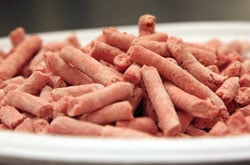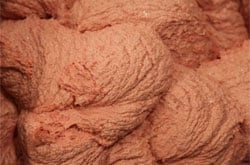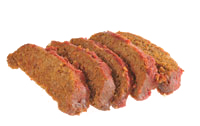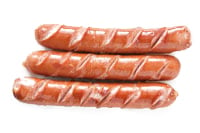Results 1 to 2 of 2
Thread Information
Users Browsing this Thread
There are currently 1 users browsing this thread. (0 members and 1 guests)
-
04-14-2012, 04:22 PM #1Senior Member


- Join Date
- May 2007
- Location
- South West Florida (Behind friendly lines but still in Occupied Territory)
- Posts
- 117,696
And You Thought It Was Just ‘Pink’ Slime
And You Thought It Was Just ‘Pink’ Slime
by Lena Groeger
ProPublica, April 12, 2 p.m.
"Lean finely textured beef," aka "pink slime," sparked an uproar when the USDA bought 7 million pounds of the stuff for school lunches. The agency maintains it's safe and healthy; critics say it's not fit to eat. But the burger filler isn't new, nor is it the only way that meat packers maximize production. Here's how it stacks up against two other mechanical processes.
Lean Finely Textured Beef Mechanically Separated Meat Advanced Meat Recovery 


"Pink slime," coined by former USDA microbiologist Gerald Zirnstein in 2002. "White slime," in the popular press. Processed beef trimmings and recovered materials from meat carcasses, like fat and connective tissue. A "paste-like and batter-like meat product" made from mechanically removing meat from animal bones. Pieces of meat that have been scraped, shaved, or pressed off the bone by special machinery. Trimmings are heated to 100°F and spun inside a centrifuge to separate the meat from the fat. After the fat is removed, the remaining beef bits are treated with ammonia hydroxide to kill bacteria such as E. coli or salmonella. They are then ground up, frozen into blocks and added to other beef products. Carcasses are forced through "a sieve or similar device under high pressure to separate bone from the edible tissue." The remaining fragments (the USDA limits how many bits of bone are acceptable) are ground up into a paste and added to other processed meats. Without grinding, crushing or pulverizing the bone itself, a machine removes edible tissue from beef and pork bones. If the resulting bits have more than 150 mg of calcium per 100 grams (indicating the presence of bones) they must be labeled "mechanically separated" meat. 
 burgers meatloaf
burgers meatloaf
 bologna hot dogs
bologna hot dogs
 taco filling meatballs
taco filling meatballsSome companies may soon include "lean finely textured beef" on their product labels, and Congress recently introduced a bill to require labeling. Right now the USDA does not require any disclosure, because the product is considered the same as beef. Manufacturers must always label "mechanically separated" pork, chicken or turkey on the ingredients list. According to the American Meat Institute, the product is no longer typically used in chicken nuggets (McDonald's has repeatedly claimed that its chicken nuggets only contain chicken breast meat). Is labeled the same way as any other meat – such as "beef" or "ground pork." Trimmings are typically collected from more bacteria-prone parts of the cow, but treatment with ammonia is supposed to kill pathogens. In 2009 some beef products tested positive for E. coli and salmonella, but the USDA says it has modified inspection processes since then to address safety concerns. The USDA continues to "affirm the safety of Lean Finely Textured Beef product for all consumers." Mechanically separated beef was prohibited for use as human food in 2004 due to concerns that spinal tissue (potentially carrying mad cow disease) could get mixed into the meat. Mechanically separated poultry and pork are still allowed. The USDA requires that the spinal cord be removed before processing the neck bones and backbones, so that pieces do not get mixed into the meat.
Sources: USDA Food Safety and Inspection Service, The American Meat Institute
Image Sources: The Associated Press, Shutterstock
And You Thought It Was Just ‘Pink’ Slime - ProPublicaJoin our efforts to Secure America's Borders and End Illegal Immigration by Joining ALIPAC's E-Mail Alerts network (CLICK HERE)
-
09-24-2012, 09:47 AM #2Guest

- Join Date
- Aug 2009
- Posts
- 9,266
Pink slime beef producer sues ABC News for $1.2 billion over report exposing sickening beef industry practices
Saturday, September 22, 2012 by: Jonathan Benson, staff writer
(NaturalNews) A major producer of the infamous "pink slime" meat product that captured headlines back in the spring is suing ABC News, news anchor Diane Sawyer, and several other individuals for what it claims was "a month-long vicious, concerted disinformation campaign" about "lean finely textured beef." Beef Products Inc. (BPI) and several of its affiliate companies are seeking a whopping $1.2 billion in damages from ABC News for exposing pink slime to the public, a move the company says "severely damaged" its business.
BPI is claiming that much of the information disseminated by ABC News about pink slime was defamatory, including its very use of the term pink slime, according to Courthouse News Service (CNS). BPI maintains that pink slime is not actually slime, but rather a legitimate form of beef that has been widely used in beef products for several decades without incident, that is until the public recently became aware of its existence.
Since 'pink slime' has never been properly labeled, shouldn't the public be suing BPI instead?
But like genetically-modified organisms (GMO), pink slime has never been properly labeled in beef products because producers like BPI have long claimed that it is just beef, and thus does not require additional labeling. But as we pointed out previously, pink slime is not just beef like BPI claims -- it is more of a beef "paste," at best, that has been heavily treated with toxic ammonia chemicals and processed into a mush that looks more like soft-serve ice cream than actual meat. (http://www.naturalnews.com)
The fact that the presence of pink slime in conventional beef has been veiled from the public for more than 20 years is much more concerning than any monetary loss that BPI and others in the industry have sustained as a result of their dirty little secret being made public. If anything, the public should be suing BPI for hiding a toxic food additive in the beef supply all these years, rather than BPI suing the media for merely doing its job by reporting on an issue that is obviously of major concern.
'Pink slime' is not just beef; many credible experts still question its safety
Even so, BPI denies that pink slime is anything other than actual beef, and continues to maintain that ABC News ran an unfair hatchet job on the product, which has resulted in many major retailers and even the McDonald's chain deciding to remove the additive from their products. Now that the public is aware of its existence, pink slime's days are clearly numbered -- and BPI seems to be fully aware of this, which is why the company is now apparently trying to extract large sums of cash from its whistleblowers and their enablers, which in this case happens to be ABC News.
"Thanks to ABC News, Kit Foshee (a former BPI employee) and other whistleblowers shared their concerns about BPI," said Amanda Hitt, Director of the Food Integrity Campaign, a whistleblower advocacy group that counseled Foshee after he was fired from BPI for speaking out about pink slime. "Doing so took enormous courage for which (ABC News) should be honored, not attacked. We believe that this product is questionable."
Sources for this article include:
Courthouse News Service
http://www.agriview.com
Learn more: Pink slime beef producer sues ABC News for $1.2 billion over report exposing sickening beef industry practices
Oh now I guess they want us to believe pink slime is now a good thing...we won't even go into the other crap they put in our food


 LinkBack URL
LinkBack URL About LinkBacks
About LinkBacks




 Reply With Quote
Reply With Quote


Durbin pushes voting rights for illegal aliens without public...
04-25-2024, 09:10 PM in Non-Citizen & illegal migrant voters